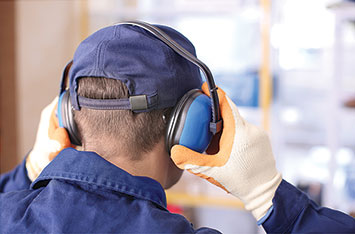 Occupational hearing loss is one of the most common work-related illnesses in the United States. Each year, about 22 million U.S. workers are exposed to hazardous noise levels at work. Over 30 million are exposed to chemicals, some of which are harmful to the ear and hazardous to hearing. In addition to damaging workers’ quality of life, occupational hearing loss carries a high economic price to society.
Occupational hearing loss is one of the most common work-related illnesses in the United States. Each year, about 22 million U.S. workers are exposed to hazardous noise levels at work. Over 30 million are exposed to chemicals, some of which are harmful to the ear and hazardous to hearing. In addition to damaging workers’ quality of life, occupational hearing loss carries a high economic price to society.
Three out of four construction workers are exposed to hazardous noise levels on the job site. Noise levels are considered hazardous when they reach 85 decibels (dB) or higher.
A study by the National Institute for Occupational Safety and Health (NIOSH) found that construction workers have higher levels of hearing loss than workers in most industries. NIOSH, a division of the Centers for Disease Control and Prevention, is the federal agency responsible for conducting research and making recommendations for the prevention of work-related injury and illness. examining hearing loss across industries.
The highest rates are experienced by construction workers in nonresidential building construction, highway and bridge construction and heavy and civil engineering. With power tools, mobile equipment, and other sources of hazardous noise present at many construction sites, workers have multiple reasons to wear hearing protection devices. Even so, one study found that one out of three construction workers exposed to hazardous noise did not wear hearing protection.
Many people do not realize that listening to music on headphones or pushing a lawnmower also can be causing damage to their hearing. The Occupational Safety and Health Administration advises that noise-induced hearing loss can be caused by prolonged exposure to any loud noise over 85 dB.
Conversational speech is normally about 60 dB, lawnmowers typically measure around 90 dB, concerts and sporting events average 110 dB, and gunshots from small firearms can cause a lot of damage to a person’s hearing at 140 dB.
A less known threat to hearing loss that is present at nearly every construction site across the country and that can cause just as much, if not more damage to hearing than loud noises, is chemicals. Many chemicals, even over-the-counter drugs such as ibuprofen, can enhance the damaging effects of noise when individuals are exposed to both loud sounds and chemicals. Many workers are unaware that hearing loss has occurred until completing an audiogram and reviewing the results with a physician or other licensed healthcare provider.
CAN AN AUDIOLOGIST HELP?
Audiologists like those at Sound Health Services, which has offices throughout the St. Louis area, diagnose, treat, and prevent hearing and balance disorders in children and adults. They must have attained either a Master’s in Audiology or Doctor of Audiology degree. In addition to their extensive training, audiologists also participate in continuing education.
You should see an audiologist if you need:
- Hearing testing or treatment.
- Hearing aid fitting and management.
- Tinnitus treatment (or ringing in the ears).
- Dizziness and balance treatment.
A TEAM APPROACH
When a patient has a hearing problem, it’s important for an audiologist to perform prompt hearing testing to determine the cause. If there is an ears, nose and throat (ENT) doctor in the same office, the audiologist can share the results of his or her evaluation with the doctor prior to his exam so the doctor knows what to look for.
Along those same lines, if an ENT doctor determines that a patient’s hearing problem can’t be corrected medically, he will want to consult with an audiologist to determine the best course of action to treat the loss and preserve hearing. And if a patient wears hearing aids, it’s nice for an ENT to be able to clear impacted wax and address other medical problems that can interfere with wearing hearing aids.
At Sound Health Services, audiologists and ENT doctors work together to ensure their patients maintain the best hearing possible. Sound Health Services offers a team of ENT physicians as well as audiologists who are specially trained in the most sophisticated diagnostic procedures. By working together, the staff can provide comprehensive care for patients with hearing disorders so they’re able to communicate with loved ones at any stage of life.
Five to 10 percent of hearing problems in adults are medically or surgically treatable. This percentage is higher in children, especially if a middle ear disease such as ear infection is the cause. If your hearing test indicates that your condition cannot be medically or surgically treated, a hearing aid evaluation will be recommended.
Call Sound Health Services at 314-729-0077 to make an appointment to develop a treatment plan.


